Better Not Burn Your Toast: The Science of Food and Health (2025)
 In a world of misinformation and noise, Dr. Joe is a reliable source of authentic, evidence-based health science to teach you everything you didn’t know you needed to know!
In a world of misinformation and noise, Dr. Joe is a reliable source of authentic, evidence-based health science to teach you everything you didn’t know you needed to know!
If you have an appetite for digestible science, you will find plenty of tasty morsels here.
Discover why some people see red over red food dyes, why Sherlock Holmes was interested in jellyfish, why King George III was plagued with purple urine, and why phrenology is a pseudoscience. You will learn about the links between the Pope, Lionel Messi, and yerba mate, Harry Potter and the mandrake root, and how Bicycle Day came to commemorate the first use of LSD. Have you ever wondered whether negative ions have positive effects, if memory supplements work, if performance-enhancing supplements really enhance performance, or if taurine in Red Bull is a lot of bull? Look no further. Are you confused about ultra-processed foods, free radicals, calcium propionate in your daily bread, endocrine disruptors, preservatives, rejuvenation, aspartame, Ozempic, Oxycontin, or whether you can eat to beat disease? You’ve come to the right place.
You will also find out why Woody Allen’s “orgasmatron” in Sleeper was a parody of an actual device created by Wilhelm Reich, how time-restricted eating works, why kimchi traveled to outer space, and where not to stick a magnesium rod. Then, of course, you will also discover why you should not burn your toast!
Superfoods, Silkworms, and Spandex: Science and Pseudoscience in Everyday Life (2024)
 In this new collection of bite-size pop science essays, bestselling author, chemistry professor, and radio broadcaster Dr. Joe Schwarcz shows that you can find science virtually anywhere you look. And the closer you look, the more fascinating it becomes. In this volume, we look through our magnifying glass at maraschino cherries, frizzy hair, duct tape, pickle juice, yellow school buses, aphrodisiacs, dental implants, and bull testes. If those don’t tickle your fancy, how about aconite murders, shot towers, book smells, Swarovski crystals, French wines, bees, or head transplants? You can also learn about the scientific escapades of James Bond, California’s confusing Proposition 65, the problems with oxygen on Mars, Valentine’s Meat Juice, the benefits of pasteurization, the pros and cons of red light therapy, the controversy swirling around perfluoroalkyl substances (PFAS), why English cucumbers are wrapped in plastic, and how probiotics may have seeded Hitler’s downfall.
In this new collection of bite-size pop science essays, bestselling author, chemistry professor, and radio broadcaster Dr. Joe Schwarcz shows that you can find science virtually anywhere you look. And the closer you look, the more fascinating it becomes. In this volume, we look through our magnifying glass at maraschino cherries, frizzy hair, duct tape, pickle juice, yellow school buses, aphrodisiacs, dental implants, and bull testes. If those don’t tickle your fancy, how about aconite murders, shot towers, book smells, Swarovski crystals, French wines, bees, or head transplants? You can also learn about the scientific escapades of James Bond, California’s confusing Proposition 65, the problems with oxygen on Mars, Valentine’s Meat Juice, the benefits of pasteurization, the pros and cons of red light therapy, the controversy swirling around perfluoroalkyl substances (PFAS), why English cucumbers are wrapped in plastic, and how probiotics may have seeded Hitler’s downfall.
Quack Quack: The Threat of Pseudoscience (2022)
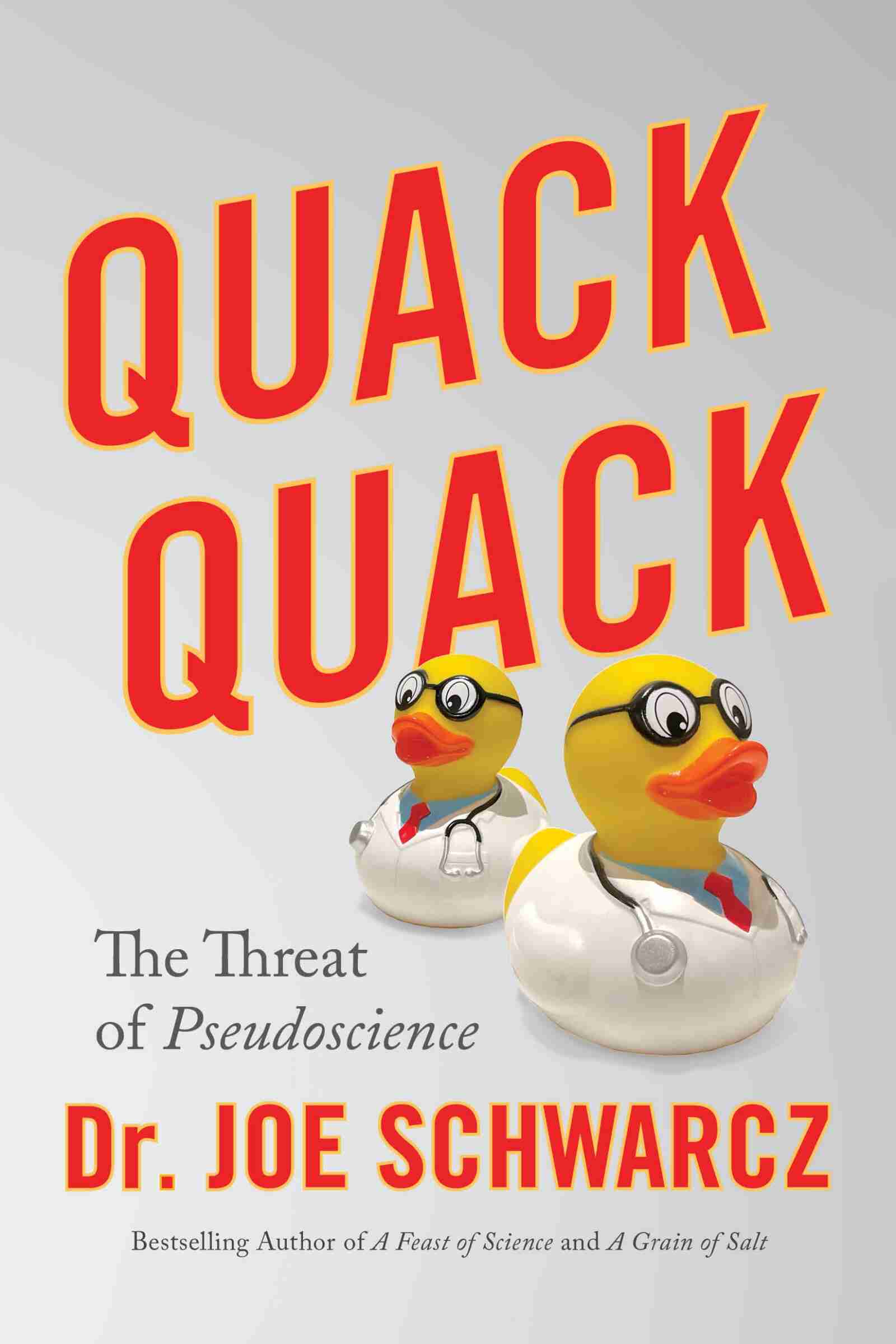
We are in a crisis. A tsunami of misinformation and disinformation is threatening to engulf evidence-based science. While quackery ― loosely defined as the spread of false “knowledge,” often accompanied by various versions of “snake oil” ― is not a novel phenomenon, it has never posed as great a threat to public health as today. COVID-19 has unleashed an unprecedented flurry of destructive information that has fueled vaccine hesitancy and has steered people toward unproven therapies. Conspiracy theorists have served up a distasteful menu of twisted facts that create distrust in science.
In Quack Quack, Dr. Joe Schwarcz, who has been battling flimflam for decades, focuses on the deluge of anecdotes, cherry-picked data, pseudoscientific nonsense, and seductive baseless health claims that undermine efforts to educate the public about evidence-based science. The wide scope of the topics drawn from past and present aims to cast a life preserver to people drowning in a sea of misinformation.
Unafraid to expose the sheer nonsense people are led to believe about health, food, drugs, and our environment, Dr. Joe confronts pseudoscience and convincingly and entertainingly advocates for a scientific approach to everyday life.
Science Goes Viral (2021)
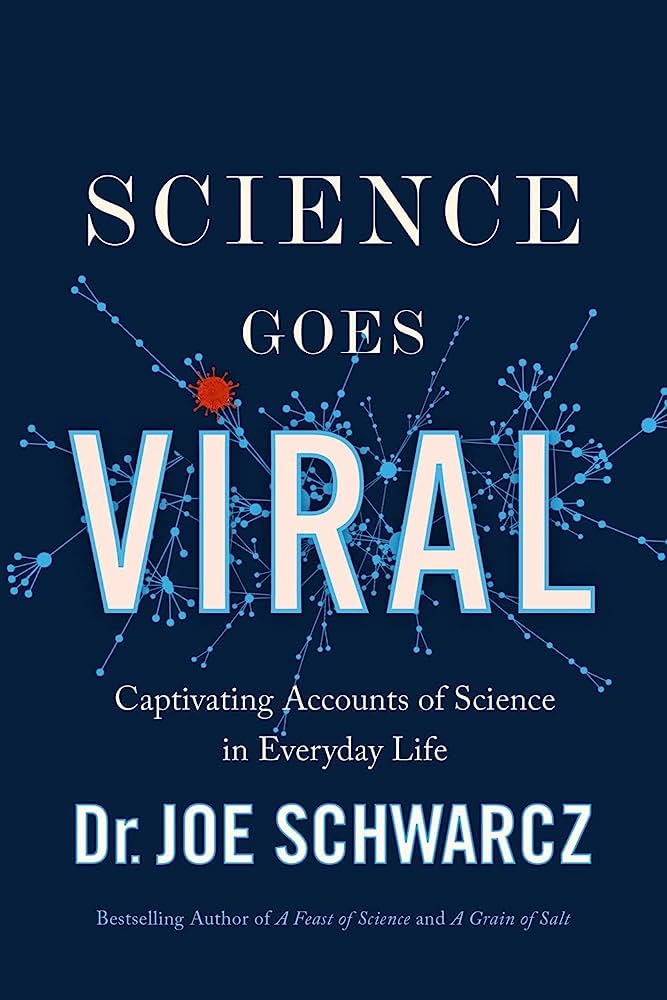 Since we first heard rumblings about a novel type of pneumonia in Wuhan, China, terms like pandemic, spike protein, viral particles, variants, mRNA vaccines, antibodies, hydroxychloroquine, social distancing, immune response, convalescent plasma, aerosol transmission, and of course, face coverings, have entered our everyday vocabulary. The scientific literature has exploded with studies exploring every facet of COVID-19, but unfortunately the “viral” spread of misinformation about the pandemic has also reached epic proportions.
Since we first heard rumblings about a novel type of pneumonia in Wuhan, China, terms like pandemic, spike protein, viral particles, variants, mRNA vaccines, antibodies, hydroxychloroquine, social distancing, immune response, convalescent plasma, aerosol transmission, and of course, face coverings, have entered our everyday vocabulary. The scientific literature has exploded with studies exploring every facet of COVID-19, but unfortunately the “viral” spread of misinformation about the pandemic has also reached epic proportions.
Science Goes Viral provides a framework for coming to grips with the onslaught of COVID-19 information and misinformation in this ever-changing pandemic. Here, you’ll learn about the first antibodies ever identified, the connection between tonic water and coronavirus, and whether we can zap COVID with copper. And although our thoughts and daily activities have been hijacked by the pandemic, life does go on, as does the pursuit of science. Dr. Joe features his usual array of diverse topics, including biblical dyes, essential oils, Jean Harlow’s hair, Lincoln’s magician, and bioplastics, along with assorted examples of quackery.
Delving into the many fascinating facets of science can serve as a welcome distraction from the COVID curse. In fact, enchantment with science can also be contagious. Will you be infected?
A Grain of Salt: The Science and Pseudoscience of What We Eat (2019)
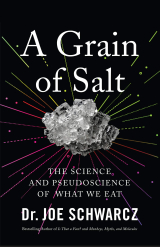
Eating has become a confusing experience. Should we follow a keto diet? Is sugar the next tobacco? Does fermented cabbage juice cure disease? Are lectins toxic? Is drinking poppy seed tea risky? What’s with probiotics? Can packaging contaminate food? Should our nuts be activated? What is cockroach milk?
We all have questions, and Dr. Joe Schwarcz has the answers, some of which will astonish you. This collection is guaranteed to satisfy your hunger for palatable and relevant scientific information as Dr. Joe separates fact from fiction with an assortment of new and updated articles about what to eat, what not to eat, and how to recognize the scientific basis of food chemistry.
A Feast of Science: Intriguing Morsels from the Science of Everyday Life (2018)
 Crave answers? A Feast of Science demystifies the chemistry of everyday life, serving up practical knowledge to both inform and entertain. Guaranteed to satiate your hunger for palatable and relevant scientific information, Dr. Joe Schwarcz proves that “chemical” is not necessarily synonymous with “toxic.” Are there fish genes in tomatoes? Can snail-slime cream and bone broth really make your wrinkles disappear? What’s the problem with sugar, resistant starch, hops in beer, microbeads, and “secret” cancer cures? Are “natural” products the key to good health? And what is “fake news” all about? Dr. Joe answers these questions and more. Cutting through the fat of story, suggestion, and social-media speculation, A Feast of Science gets to the meat of the chemical reactions that make up our daily lives.
Crave answers? A Feast of Science demystifies the chemistry of everyday life, serving up practical knowledge to both inform and entertain. Guaranteed to satiate your hunger for palatable and relevant scientific information, Dr. Joe Schwarcz proves that “chemical” is not necessarily synonymous with “toxic.” Are there fish genes in tomatoes? Can snail-slime cream and bone broth really make your wrinkles disappear? What’s the problem with sugar, resistant starch, hops in beer, microbeads, and “secret” cancer cures? Are “natural” products the key to good health? And what is “fake news” all about? Dr. Joe answers these questions and more. Cutting through the fat of story, suggestion, and social-media speculation, A Feast of Science gets to the meat of the chemical reactions that make up our daily lives.
Monkeys, Myths, and Molecules (2015)
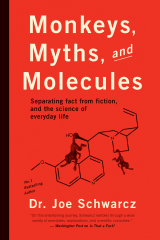
The internet is a powerful beast when it comes to science; the answer to any query you may have is just a few keystrokes away. But when there are multiple answers from various sources, how do we know what information is reliable? In Monkeys, Myths, and Molecules, bestselling author Dr. Joe Schwarcz takes a critical look at how facts are misconstrued in the media. He debunks the myths surrounding canned food, artificial dyes, SPF, homeopathy, cancer, chemicals, and much more.
Unafraid to expose the sheer nonsense people are led to believe about health, food, drugs, and our environment, Dr. Joe confronts pseudoscience and convincingly and entertainingly advocates for a scientific approach to everyday life.
The Smart Palate: Delicious Recipes for a Healthy Lifestyle (2014)
 Winner: Gourmand World Cookbook Awards 2015: Health and Nutrition, Institutions Winner: Gourmand World Cookbook Awards: Best in The World in the Fund Raising, North America Catering to those who want to be as health conscious as they are passionate about food, The Smart Palate is a delightful cookbook featuring over 180 triple-tested recipes, full-colour photographs, chef's tips, smart food facts, and nutritional analyses for every meal from breakfast to dessert, covering everything from smoothies, soups, and salads to grains, meats, and sweets. Providing information on how to incorporate wholesome, perhaps unfamiliar, ingredients into everyday menus, this book showcases novel methods to prepare traditional favourites in healthful ways. Sugars and fats are adjusted in the recipes to minimal amounts or substituted altogether with alternative ingredients without compromising taste. While fresh, local ingredients are emphasized, the need for frozen and canned goods in a fast-paced, busy life is also taken into account. Popular Montreal chemistry professor Joe Schwarcz weighs in with science-based information on the health benefits of many of the foods featured here, as well as fascinating historical facts about their origins. A fundraising project endorsed by the McGill University Faculty of Medicine that also honours the scientists at McGill's Goodman Cancer Research Centre, The Smart Palate offers indispensable guidelines for choosing and preparing foods that sustain and enrich a healthy life.
Winner: Gourmand World Cookbook Awards 2015: Health and Nutrition, Institutions Winner: Gourmand World Cookbook Awards: Best in The World in the Fund Raising, North America Catering to those who want to be as health conscious as they are passionate about food, The Smart Palate is a delightful cookbook featuring over 180 triple-tested recipes, full-colour photographs, chef's tips, smart food facts, and nutritional analyses for every meal from breakfast to dessert, covering everything from smoothies, soups, and salads to grains, meats, and sweets. Providing information on how to incorporate wholesome, perhaps unfamiliar, ingredients into everyday menus, this book showcases novel methods to prepare traditional favourites in healthful ways. Sugars and fats are adjusted in the recipes to minimal amounts or substituted altogether with alternative ingredients without compromising taste. While fresh, local ingredients are emphasized, the need for frozen and canned goods in a fast-paced, busy life is also taken into account. Popular Montreal chemistry professor Joe Schwarcz weighs in with science-based information on the health benefits of many of the foods featured here, as well as fascinating historical facts about their origins. A fundraising project endorsed by the McGill University Faculty of Medicine that also honours the scientists at McGill's Goodman Cancer Research Centre, The Smart Palate offers indispensable guidelines for choosing and preparing foods that sustain and enrich a healthy life.
Is That a Fact? (2014)
 Eat this and live to 100. Don’t, and die. Today, hyperboles dominate the media, which makes parsing science from fiction an arduous task when deciding what to eat, what chemicals to avoid, and what’s best for the environment. In Is That a Fact?, bestselling author Dr. Joe Schwarcz carefully navigates through the storm of misinformation to help us separate fact from folly and shrewdness from foolishness.
Eat this and live to 100. Don’t, and die. Today, hyperboles dominate the media, which makes parsing science from fiction an arduous task when deciding what to eat, what chemicals to avoid, and what’s best for the environment. In Is That a Fact?, bestselling author Dr. Joe Schwarcz carefully navigates through the storm of misinformation to help us separate fact from folly and shrewdness from foolishness.
Are GMOs really harmful? Or could they help developing countries? Which “miracle weight-loss foods” gained popularity through exuberant data dredging? Is BPA dangerous or just a victim of unforgiving media hype? Is organic better? Dr. Joe questions the reliability and motives of “experts” in this lighthearted but critical look at what’s fact and what’s plain nonsense.
The Right Chemistry (2012)
 A big part of Dr. Joe's job as director of McGill University's Office of Science and Society is persuading people that the pursuit of science knowledge is a potential source of wonder, enlightenment and well-being for everyone. And as a chemist, he's particularly keen to rescue chemistry from the bad rep it's developed over recent decades. There is more to chemistry than toxins, pollution, and "Don't drink that soda--it's full of chemicals."
A big part of Dr. Joe's job as director of McGill University's Office of Science and Society is persuading people that the pursuit of science knowledge is a potential source of wonder, enlightenment and well-being for everyone. And as a chemist, he's particularly keen to rescue chemistry from the bad rep it's developed over recent decades. There is more to chemistry than toxins, pollution, and "Don't drink that soda--it's full of chemicals."
The evangelic zeal Dr. Joe brings to his day job is of course also the driving force behind his work as an author. Once again, here he is to tell that everything is full of chemicals, and that chemistry means health, nutrition, beauty products, cleaning products, DNA, and the means by which Lady Gaga's meat dress was held together. In the style established with the bestselling Brain Fuel, each section here is themed and contains a mixture of short, pithy items and slightly longer mini-essays. And as before--but never with such energy and relish--Dr. Joe goes on the attack against charlatans in the alternative health trade, naming and shaming them in a particularly entertaining and edifying section of the book called "Claptrap."
You will learn whether to put broccoli on a pizza before or after baking, whether beauty pills are worth taking, and whether the baby shampoo you're using is poisonous. You will discover but not use, please, the recipe for a Molotov cocktail. You will be enabled to enthrall fellow dinner guests with the derivation of the name Persil, and the definition of a kangarian (it's someone who only eats kangaroo meat).
As ever, this torrent of entertainment is delivered in Dr. Joe's unmistakably warm, lively and authoritative voice.
Dr. Joe's Health Lab (2011)
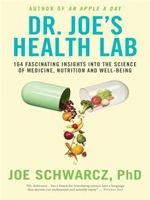
Health Lab's theme is the most popular of Dr Joe's specialities. There are riveting and sometimes hair-raising vignettes from the history of medicine and food production. There are reports aimed at equipping readers to recognize and beware muddled thinking, misunderstandings and deceptions in media stories about health and nutrition and in the claims made by the peddlers of "alternative" therapies. There is a wealth of information on the science of inner well-being and outer beauty. The secret to good health lies in understanding the chemistry involved. Ask Dr. Joe.
Dr. Joe's Brain Sparks (2010)

Did you know what when you shake a ketchup bottle you're practicing thixotropy? That the ancient Greeks made themselves look less ancient by inventing moisturizer? That the mysterious drug obecalp* is as effective as homeopathy and many herbal cures?
From the bestselling author of An Apple a Day, Brain Fuel, and Science, Sense and Nonsense comes a fresh batch of inquiries into the science of everyday life. Dr. Joe, as he is affectionately known to millions of readers, listeners, viewers, and students, presents his third book in the Doubleday Canada series he launched with Brain Fuel.
Using a Q&A format, it explains the world through science, and science through our common experience. There are sections on diet and nutrition, new drugs, and the dubious claims made for alternative remedies and beauty potions. There is a profusion of inspiring, enlightening, sometime just downright bizarre information drawn from the laboratory, from history, from our medicine cabinets and the bottles under our sinks. Science is everywhere, and Dr. Joe is keeping track - and doing it in a marvellously warm, eminently readable style. Let the brain sparks fly!
Brain Fuel (2010)

Dr. Joe – as he is affectionately known to millions of readers, listeners, viewers, and students – brings his magic formula to Doubleday Canada with Brain Fuel.
As with Dr. Joe’s previous best-selling books, Brain Fuel informs and entertains on a wild assortment of science-based topics. But this is not "science trivia." If you are looking for serious scientific discussions, you’ll find them here. If you are looking for practical consumer information, that’s here too. If you are searching for ways to stimulate interest in science, look no further, Mom. And if you are simply wondering why the birth of Prince Leopold was so different from Queen Victoria's previous seven; or why an iron rod that went through a man's head is now on display in a museum in Boston; or why white chocolate has such a short shelf life; or why eggs terrified Alfred Hitchcock – and what all of this means for the rest of us, and why – then bingo.
Science, Sense and Nonsense (2009)
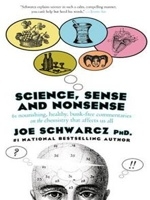 Forty or so years ago, chemistry—which had been recognized as a miracle-making boon to humanity—somehow became associated with warfare, sinister food additives, “toxins” and pollution. It’s a situation that Dr. Joe Schwarcz aims to put into perspective.
Forty or so years ago, chemistry—which had been recognized as a miracle-making boon to humanity—somehow became associated with warfare, sinister food additives, “toxins” and pollution. It’s a situation that Dr. Joe Schwarcz aims to put into perspective.
Yes, there’s a downside to chemistry, he says, but this is dwarfed by its enormous benefits. Dr. Joe’s new collection of commentaries will inspire an appreciation for the science of everyday life, and equip you to spot the muddled thinking, misunderstandings and deceptions in media stories and advertising claims. Does organic food really always equal better food? Are vaccines dangerous? Will the latest health fad make you ill? Do expensive wrinkle creams do the job? What are the best ways to avoid cancer?
The answers to such questions often lie in an understanding of the chemistry involved. Ask Dr. Joe. Science, Sense and Nonsense celebrates chemistry’s great achievements, lambastes its charlatans, and explores its essential connections to our wellbeing. And does so in authoritative, highly readable, good humoured style.
An Apple A Day (2008)

Eat Salmon. It's full of good omega-3 fats. Don't eat salmon. It's full of PCBs and mercury. Eat more veggies. They're full of good antioxidants. Don't eat more veggies. The pesticides may cause cancer. It seems you have to be a nutritional scientist these days before you sit down to eat - which is why we need Dr. Joe Schwarcz.
In An Apple a Day, he has taken this thorough knowledge of food chemistry, applied it to today's top food misconceptions, myths, trends and questions, and leavened it with his trademark lighthearted approach. The result is an entertaining revelation of the miracles of science happening in our bodies every time we take a bite.
Looking first at how food affects our health, Schwarcz examines the body's chemical reactions to healthy foods. Then he investigates how we manipulatet our food supply, delving into the science of food additives and what benefits we might realize from adding bacteria to certain foods. He clears up the confusion about contaminants, examining everything from pesticide residues and remnants of antibiotics to the dreaded trans fats and chemicals that may be leached from cookware. And he takes a studied look at the science of calories and weighs in on popular diets.
An Apple a Day is a must-read book for anyone who hungers for the truth about what we eat.
Let them Eat Flax (2005)
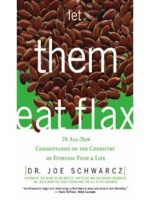
Chemistry, according to Joe Schwarcz, is the thread that ties life together. In his latest work, "Let Them Eat Flax," Schwarcz continues to reveal the mysteries of the chemistry of daily life in his inimitable style, blending modern science with history, always with a bit of whimsy thrown in. He investigates a broad range of subjects ranging from vitamin supplements and pesticides to acupuncture and dynamite. Schwarcz gives credit when it is due, as in the development of penicillin or paper, but does not hesitate to poke fun at the quackery involved in promoting nonsensical cancer treatments or "living enzymes." Along with a myriad of other topics, the reader learns about trans fats, blue garlic, organic agriculture, hair dyes, exploding trousers and the chemical magic behind a Stradivarius. And there is plenty of healthy advice dispensed as well. The latest findings on blueberries, cinnamon, coffee and chocolate are explored, and of course, you'll find out why many researchers, when considering the health of the population, are saying "let them eat flax!"
Foods that Harm Foods that Heal (2004)
 The whole truth about the foods you eat.
The whole truth about the foods you eat.
Which is healthier: beef or tuna? Margarine or butter? Wine or beer? The truth is, it's not always obvious which foods are good for you and which ones aren't. The phenomenal Canadian bestseller "Foods That Harm, Foods That Heal" sets the record straight with authoritative entries on foods from apples to zucchini. Learn which ones can fight cancer, free you from pain, slow the aging process, sharpen your mind, and help you sleep. Find out the secret health benefits of coffee, chocolate, nuts, and shrimp. And discover the little-known hazards of fruit juice, grilled foods, energy bars, and fast-food salads. Ailment entries tell which foods help - or hurt - health conditions from allergies to diabetes to ulcers. And special features explain everything you need to know about low-carb diets, trans fats, omega-3 fatty acids, the glycemic index, and more.
Let food be your medicine, and let "Foods That Harm, Foods That Heal" show you how.
The Fly in the Ointment (2004)

Following on the heels of his best-sellers, "Radar Hula Hoops and Playful Pigs," "The Genie In The Bottle," "That's The Way The Cookie Crumbles" and “Dr. Joe And What You Didn’t Know,” Joe Schwarcz once again takes up the challenge of demystifying the science that surround us. His critical eye focuses on topics ranging from pesticides and environmental estrogens to lipstick and garlic. There are accounts to inform and delight everyone. You'll learn about the benefits of broccoli and the pitfalls of "natural" remedies. You'll be entertained with stories about laughing gas and green-haired Swedes and you'll find out why some people drill holes in their head for "enlightenment." Schwarcz investigates aphrodisiacs, DDT, bottled waters, vitamins, barbiturates, plastic wraps, Alzheimer’s Disease, fish-odor syndrome and smoked meat. He explores the science of Agatha Christie, Harry Potter and Erin Brockovitch and tells us how an unfortunate Patricia Stallings was almost found guilty of murdering her son as a result of a chemical error. As in his other books, Professor Schwarcz alerts the reader to the shenanigans of quacks and offers glimpses into the fascinating history of science. He puts worries about acrylamide, preservatives and wax on fruits into perspective and unravels the mysteries of bullet-proof vests, weight loss diets and "mad honey." The reader even learns about possibles ways to deal with menopause and the curious are enlightened about the origins of the expression “take a bromide.” Schwarcz relishes proper scientific investigation but understands that while science offers us tremendous advantages, there often seems to be "a fly in the ointment."
Dr. Joe & What You Didn't Know (2003)

Linus Pauling, one of the most celebrated scientists of the twentieth century once remarked that satisfying curiosity is one of the greatest sources of pleasure in life. This book aims to provide such pleasure through a plethora of questions and answers designed to inform as well as entertain. The questions range from the esoteric (what is Beethoven’s connection to plumbing?) to the common (how do fish become contaminated with mercury?) If you have ever wondered about the difference between green, black and oolong tea, or what foods can be refrozen, or how marshmallows are made, or why burnt light bulbs have a black deposit, or what “emu” oil is, or why milk is white or why rotten eggs smell like rotten eggs, you’re in the right place. You’ll also learn which antibiotic was discovered thanks to a sick chicken and how to tell the difference between a blood stain and Taco sauce.
Why did a town in Florida ban the planting of Angels’ Trumpets? What plant food can cause death or paralysis if not properly processed? Why did scientists dump six pig carcasses into Lake Ontario? How was Dr. Nooth’s apparatus supposed to maintain health? How did a sheep a duck and a rooster usher in the age of air travel? What is the chemical link between the launch of the Space Shuttle and the welding of rails? What metal is prohibited in jewelry in some European countries? How was Romeo poisoned? What does Miss Piggy have to do with the World Cup? How are executions in gas chambers carried out? What’s the problem with Paul Revere’s gravestone? Is there a danger in eating green potatoes? How did dinosaurs help create caves? Can you really keep the fizz in a soft drink with the Fizz Keeper? Why does ouzo turn white when water is added? The answer to all of these mysteries is revealed in a concise, but thoroughly scientific fashion, often speckled with whimsy.
You’ll also find out how sick silkworms and a spilled bottle led to the development of rayon and how a sheepdog that bit into a mollusk on a beach started a whole industry. You’ll learn how vitamins got their names, how to prevent brown sugar from lumping and why students are told not to wear false fingernails in chemistry labs. If you have ever wondered about how “carbonless” carbon paper is made, or why eating foods from dented cans may be risky, or whether wrapping food in plastic is safe, or whether you can lose weight by eating ice, you’ll wonder no more. You’ll even discover why cooked onions don’t make you cry, why adding lemon juice to tea lightens its color and why during a celebrated trial a lethal dose of morphine was administered to a cat. There’s practical advice to be had as well. You’ll find out what’s in windshield washer fluid and why thin French fries may be healthier than thick ones. And you’ll even learn how to remove a cockroach from your ear! That advice alone may be worth the price of the book.
That's the Way the Cookie Crumbles (2002)

Following on the heel of the success of "Radar, Hula Hoops and Playful Pigs" and "The Genie In The Bottle," Joe Schwarcz delights us once more with a brand new collection of educational and entertaining commentaries about the world of science. "That's The Way The Cookie Crumbles" is an informative and eye-opening romp that separates sense from nonsense, fact from myth. Along the way we also get a dose of history and a glimpse of advances to come. Schwarcz gives us the lowdown on mercury in our teeth, arsenic in our water, lead in our environment and aspartame in our food. He helps us understand the problem of gluten intolerance, the benefits of the "sunshine vitamin," and the pros and cons of genetically modified organisms. Paprika's peppery past comes alive and the secret life of bagels is revealed. We learn how to lower cholesterol with oats, how to take advantage of spinach and broccoli and even how to make "oobleck." Once you discover their fascinating chemistry, you'll never look on spiders, ice cream or under-arm sweat the same way!
"Functional foods," airbags, beer and soap yield their secrets. A journalist's error, you'll discover, led to the founding of the Nobel Prizes and the effect of cold temperatures on tin caused Napoleon's soldiers to lose their pants during the Russian campaign. "Dr. Joe" explores the history of nerve gases, the dark side of radium's glow and the link between contact lenses and the Battle of Britain. In a "Little Night Magic" he explains the ups and downs of fireworks and tells us all about the curious antics of Dr. John Harvey Kellogg in an appropriately titled piece, "Medicine or Malarkey?" It may come as a surprise to learn that that Edison did not invent the light bulb or that walking on hot coals does not require paranormal powers. You will chuckle, and hucksters will bristle, as Schwarcz takes a witty look at "erect electrons" and other types of scientific hogwash and balderdash. There is plenty of practical advice as well. If you want to know how to remove practically any stain from clothes, it's here. So is a discussion of the right cookware to use. You'll learn about reducing the risks of barbecuing and the possible benefits of Coenzyme Q10. And, of course, you will discover why the cookie crumbles!
The Genie in the Bottle (2001)

The Genie in the Bottle makes science down right palatable. And enjoyable. In an entertaining, breezy fashion Joe Schwarcz tackles a wide array of subjects that will interest virtually everyone. Want to know the latest on chocolate research? It’s there. So is the low-down on flax, hot peppers, mercury, magnesium and blueberries. You’ll learn about the history of margarine and share in the bitter lesson of thalidomide. Teflon, toad slime, marijuana, St’ John’s Wort and asbestos will yield their chemical secrets. You’ll read about the ups of helium and the downs of drain cleaners. You’ll get a different twist on licorice and you’ll travel to the dark side of the sun. You’ll even find out how the right socks can control foot fragrance and why bug juice is used to color ice cream. Ever wonder why Bunsen played with burners and Mendeleev with tables? Or how Anton Mesmer mesmerized his patients? Read all about it here!
Interested in how spies used secret inks or how acetone changed the course of history? How glue holds stuff together? Or how psychics bend spoons and minds? Want to find out how a young man’s interest in thallium resulted in one of the most sensational murder cases in history? Or why drugs sold at raves are nothing to rave about? It’s all here! Have you ever heard of Horace Fletcher or his suggestion that the secret to good health lay in chewing properly? Or how Dr. John Snow made one of the greatest contributions to public health by removing the handle of a water pump? Is spontaneous human combustion just flaming nonsense? Can crystals cure disease? Can sour cherries help arthritis? What is sodium lauryl sulfate and why are people saying such terrible things about this poor chemical? How is the willow tree connected to aspirin? What’s with mules and borax? How did the simple act of hand washing change the face of medicine? Want to find out? There answers are all here! You’ll even find out whether ginkgo biloba supplements will help you remember them! And if your curiosity is still not satisfied, Schwarcz goes on to investigates the mystery of the “exploding shrimp,” he gives you the poop on methane and reveals how microbes once served as a form of entertainment. And finally, he tells us about ether bunnies, explores elephant toothpaste and reveals the secret of the Genie in the Bottle.
Radar, Hula Hoops, and Playful Pigs (1999)
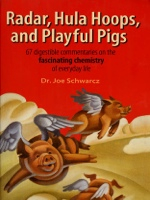
"Radar, Hula Hoops and Playful Pigs" is a compilation of 67 fascinating stories and commentaries about science in our lives. There is something here for everyone. Readers interested in health issues will get their fill with the latest on soybeans, tomatoes, antioxidants, tea, homeopathy, alternative medicine, ginseng and the benefits of eating chalk. Cooks will learn the secrets behind chicken soup, hot dogs and the perfect hard-boiled egg. Lovers can explore the science of chocolates and the whiff of romance in their armpits. There are stories about the ups and downs of underwear, the invention of gunpowder, witchcraft in Salem and zombies in Haiti. Van Gogh's brain, John Dillinger's chemical exploits, little Mikey's exploding stomach and Dinshah Ghadiali's bizarre attempts to cure disease with colored lights vie for your attention. You can explore the science behind Alice’s strange adventures in Wonderland, Rumpole’s murderous cheese soufflé and Casanova’s tinkerings with “Spanish Fly.” Delve into the nefarious chemistry of the KGB, the colors of urine and the mysteries of baldness. Find out how virgins can reduce anxiety and how Chinese Restaurant Syndrome may increase it. Practical information is to be had as well. Get rid of that skunk smell in a jiffy, find out how shampoos work and learn which cleaning agents must never be combined. Even Houdini makes a magical appearance. So does Le Petomane, the celebrated artist who tantalized audiences with the most unusual of wind instruments-himself. There’s even an easily digestible look into passing gas and a painless glimpse into the discovery of anesthetics. And finally, you’ll discover the amazing links between radar, hula hoops and playful pigs!

